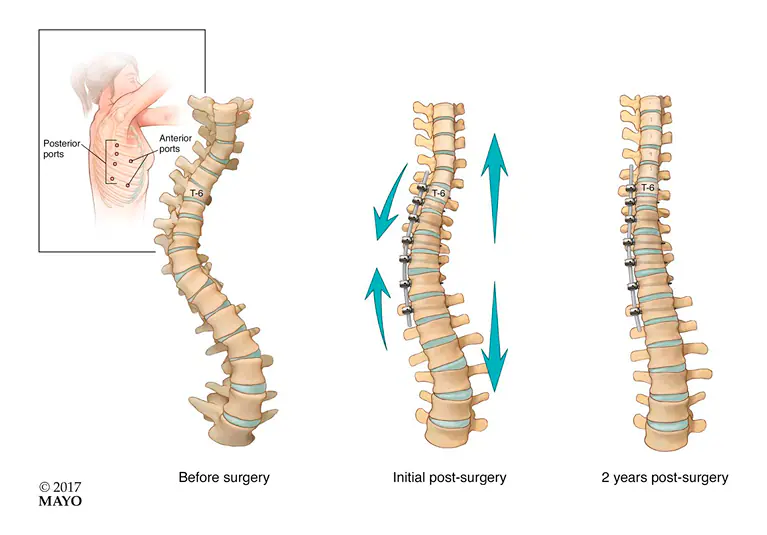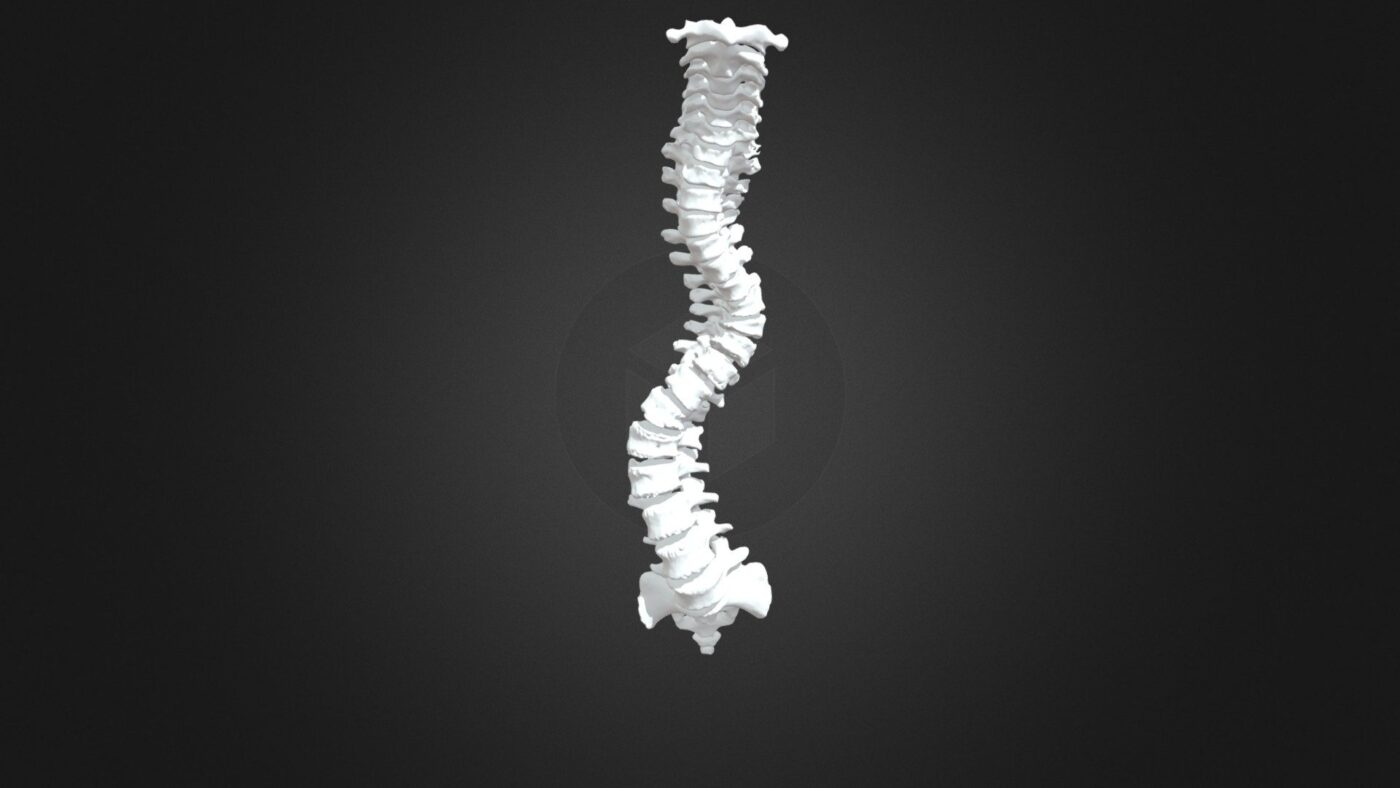La scoliose est une affection caractérisée par une courbure anormale de la colonne vertébrale. Un type spécifique de scoliose est connu sous le nom de scoliose en S, qui affecte la région thoraco-lombaire de la colonne vertébrale. Cet article vise à fournir une vue d'ensemble de la scoliose en S de la colonne thoraco-lombaire, y compris son diagnostic et les options de traitement.
Introduction à la Scoliose en S de la colonne thoraco-lombaire
La scoliose en S désigne une courbure de la colonne vertébrale qui, vue de dos, ressemble à la lettre "S". Elle affecte généralement la région thoraco-lombaire, c'est-à-dire la zone où la colonne thoracique (haut du dos) fait la transition avec la colonne lombaire (bas du dos). Cette affection peut entraîner des douleurs, une gêne et des limitations fonctionnelles importantes pour les personnes qui en sont atteintes.

Comprendre l'anatomie de la colonne vertébrale thoraco-lombaire
Pour mieux comprendre la scoliose en S de la colonne thoraco-lombaire, il est essentiel d'avoir une connaissance de base de l'anatomie de cette région. La colonne vertébrale thoraco-lombaire se compose de douze vertèbres thoraciques et de cinq vertèbres lombaires. Ces vertèbres sont reliées entre elles par des disques intervertébraux, qui leur confèrent souplesse et absorption des chocs. La colonne vertébrale abrite également la moelle épinière, qui transmet les signaux nerveux entre le cerveau et le reste du corps.
Signes et symptômes de Scoliose thoraco-lombaire en forme de S Région
Les signes et symptômes de la scoliose en S dans la région thoraco-lombaire peuvent varier en fonction de la gravité de la courbure. Les symptômes les plus courants sont des douleurs dorsales, des raideurs musculaires, un alignement irrégulier des épaules ou des hanches et une asymétrie visible de la colonne vertébrale. Certaines personnes peuvent également éprouver des difficultés à respirer ou des problèmes digestifs en raison de la compression des organes causée par la courbure anormale.
Outils et techniques de diagnostic pour la scoliose en S
Pour diagnostiquer une scoliose en S de la colonne thoraco-lombaire, les professionnels de santé utilisent différents outils et techniques de diagnostic. La méthode de dépistage initiale la plus courante est l'examen physique, au cours duquel le professionnel de santé évalue la posture du patient, l'amplitude de ses mouvements et tout signe visible de courbure de la colonne vertébrale. En cas de suspicion de scoliose, des examens d'imagerie complémentaires sont généralement recommandés.
Imagerie radiologique pour le diagnostic de la scoliose en S de la colonne thoraco-lombaire
L'imagerie radiographique est la méthode de référence pour diagnostiquer la scoliose, y compris la scoliose en S de la colonne thoraco-lombaire. Les radiographies fournissent des images détaillées de la colonne vertébrale, permettant aux professionnels de la santé de mesurer le degré de courbure et d'identifier toute anomalie associée. Ces images aident également à déterminer l'approche thérapeutique appropriée en fonction de la gravité de l'affection.

Autres modalités d'imagerie pour l'évaluation de la scoliose en S
Outre les radiographies, d'autres modalités d'imagerie peuvent être utilisées pour évaluer la scoliose en S dans la région thoraco-lombaire. L'imagerie par résonance magnétique (IRM) peut fournir des informations plus détaillées sur les tissus mous entourant la colonne vertébrale, tels que la moelle épinière et les nerfs. La tomodensitométrie (CT) peut être utilisée pour évaluer les structures osseuses et détecter toute anomalie pouvant nécessiter une intervention chirurgicale.
Classification et gradation de la scoliose en S dans la région thoraco-lombaire
La scoliose en S dans la région thoraco-lombaire est classifiée et classée en fonction de l'angle de Cobb, qui mesure le degré de courbure. Une scoliose légère est généralement définie par un angle de Cobb compris entre 10 et 25 degrés, une scoliose modérée par un angle de 25 à 40 degrés et une scoliose sévère par un angle de Cobb supérieur à 40 degrés. Cette classification permet d'orienter les décisions thérapeutiques et de prédire l'évolution potentielle de la maladie.
Options de traitement non chirurgical de la scoliose en S
Les options thérapeutiques non chirurgicales constituent souvent la première ligne de traitement de la scoliose en S de la colonne thoraco-lombaire, en particulier dans les cas légers à modérés. Ces options thérapeutiques visent à soulager la douleur, à améliorer la posture et à prévenir la progression de la courbure. Des exercices de kinésithérapie, des soins chiropratiques et des techniques de gestion de la douleur telles que les médicaments ou l'acupuncture peuvent être recommandés.
Techniques d'attelle pour la prise en charge de la scoliose en S de la colonne thoraco-lombaire
L'attelle est une autre option de traitement non chirurgical couramment utilisée pour traiter la scoliose en S de la colonne thoraco-lombaire, en particulier chez les adolescents présentant une courbure modérée. Les appareils orthopédiques sont conçus pour appliquer des forces correctives à la colonne vertébrale, ce qui permet d'arrêter ou de ralentir la progression de la courbure. Le type et la durée de l'appareillage dépendent de la gravité de la scoliose et du potentiel de croissance de l'individu.

Interventions chirurgicales pour corriger la scoliose en S
En cas de scoliose sévère en forme de S dans la région thoraco-lombaire ou lorsque les traitements non chirurgicaux n'apportent pas de soulagement adéquat, une intervention chirurgicale peut s'avérer nécessaire. L'objectif premier de la chirurgie est de corriger la courbure de la colonne vertébrale et de la stabiliser. Pour ce faire, on procède généralement à une fusion vertébrale, c'est-à-dire que les vertèbres concernées sont fusionnées à l'aide de greffes osseuses et d'implants métalliques.
Soins postopératoires et rééducation pour les patients atteints de scoliose en forme de S
Après avoir été opérés d'une scoliose en S de la colonne thoraco-lombaire, les patients ont besoin de soins postopératoires et d'une rééducation pour garantir une récupération optimale. Il peut s'agir d'une prise en charge de la douleur, d'une thérapie physique et d'une augmentation progressive des niveaux d'activité sous la supervision de professionnels de la santé. Des rendez-vous de suivi réguliers et des examens d'imagerie sont essentiels pour surveiller les progrès et détecter toute complication potentielle.
Prise en charge à long terme et pronostic de la scoliose en S dans la région thoraco-lombaire
La prise en charge à long terme de la scoliose en S dans la région thoraco-lombaire se concentre sur le maintien de l'alignement de la colonne vertébrale, la gestion de la douleur et la prévention de la progression de la courbure. Des examens réguliers avec des professionnels de la santé, le respect des exercices ou des attelles prescrits et un mode de vie sain peuvent contribuer à un meilleur pronostic. Toutefois, il est important de noter que le pronostic peut varier en fonction de la gravité de la scoliose et de facteurs individuels.
En conclusion, la scoliose en S de la colonne thoraco-lombaire est un type spécifique de courbure de la colonne vertébrale qui peut entraîner une gêne importante et des limitations fonctionnelles. Un diagnostic précoce et un traitement approprié sont essentiels pour gérer efficacement cette pathologie. Grâce à une combinaison d'outils de diagnostic, d'interventions non chirurgicales et d'options chirurgicales, les professionnels de la santé peuvent aider les personnes atteintes de scoliose en S à obtenir un meilleur alignement de la colonne vertébrale, à soulager la douleur et à améliorer leur qualité de vie.
Références
- Weinstein SL, Dolan LA, Cheng JC, et al. "Adolescent idiopathic scoliosis". Lancet. 2008;371(9623):1527-1537. doi: 10.1016/S0140-6736(08)60658-3. Lien
- Negrini S, Donzelli S, Aulisa AG, et al. "2016 SOSORT guidelines : Traitement orthopédique et de rééducation de la scoliose idiopathique pendant la croissance." Scoliose et troubles de la colonne vertébrale. 2018;13:3. doi : 10.1186/s13013-018-0175-8. Lien
- Trobisch P, Suess O, Schwab F. "Scoliose idiopathique". Dtsch Arztebl Int. 2010;107(49):875-883. doi : 10.3238/arztebl.2010.0875. Lien
- Hresko MT. "Pratique clinique. Scoliose idiopathique chez les adolescents". N Engl J Med. 2013;368(9):834-841. doi : 10.1056/NEJMcp1209063. Lien
- Bettany-Saltikov J, Weiss HR, Chockalingam N, et al. "Surgical versus non-surgical interventions in people with adolescent idiopathic scoliosis". Cochrane Database Syst Rev. 2015;2015(4). doi : 10.1002/14651858.CD010663.pub2. Lien
- Administration de la sécurité sociale. "Prestations d'invalidité". Lien
- Lonstein JE, Carlson JM. "The prediction of curve progression in untreated idiopathic scoliosis during growth" (La prédiction de la progression de la courbe dans la scoliose idiopathique non traitée pendant la croissance). J Bone Joint Surg Am. 1984;66(7):1061-1071. doi : 10.2106/00004623-198466070-00008. Lien
- Kaspiris A, Grivas TB, Weiss HR, Turnbull D. "Scoliosis : Examen du diagnostic et du traitement". Journal international d'orthopédie. 2013;37(1):34-42. doi : 10.1038/s41390-020-1047-9. Lien
- Monticone A, Cazzaniga D, Rocca B, Ferrante S. "Effects of a multimodal exercise program on patients with adolescent idiopathic scoliosis : A randomized controlled trial". Scoliose et troubles de la colonne vertébrale. 2016;11:15. doi : 10.1186/s13013-016-0060-1. Lien
- Weiss HR, Moradi B, Schreiber S, et al. "Bracing for scoliosis in children and adolescents". Cochrane Database Syst Rev. 2013;2013(4). doi : 10.1002/14651858.CD003368.pub3. Lien
- Berven SH, Wong R, Grabel L. "Scoliose : Vue d'ensemble et prise en charge". Orthop Clin North Am. 2015;46(2):179-191. doi : 10.1016/j.ocl.2014.12.002. Lien
- McMaster MJ, Lonstein JE, D'Andrea LP. "Le traitement de la scoliose idiopathique chez l'adulte". Colonne vertébrale. 2004;29(7). doi : 10.1097/01.BRS.0000119056.93030.39. Lien
- Weinstein SL, Dolan LA. "Scoliosis : A comprehensive review". Orthopédie. 2004;27(4):233-240. doi : 10.3928/0147-7447-20040701-03. Lien
- Hsu LC, Cheng JCY. "Scoliose idiopathique de l'adolescent : An update". Eur Spine J. 2008;17(5):757-767. doi : 10.1007/s00586-008-0677-3. Lien
- Schreiber S, Parent EC, Nordin M, et al. "Bracing for idiopathic scoliosis in adolescents : An updated systematic review". Scoliose et troubles de la colonne vertébrale. 2019;14:9. doi : 10.1186/s13013-019-0162-7. Lien

